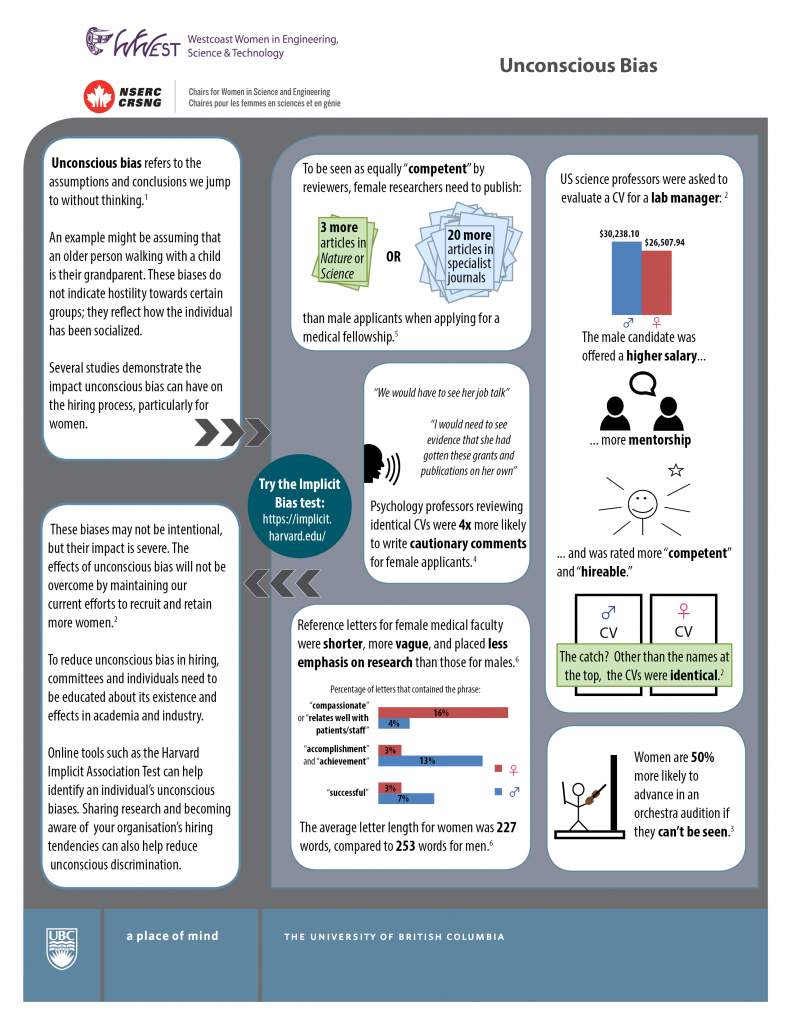Unconscious bias refers to the assumptions and conclusions we jump to without thinking.1
An example might be assuming that an older person walking with a child is their grandparent. These biases do not indicate hostility towards certain groups; they reflect how the individual has been socialized.
Several studies demonstrate the impact unconscious bias can have on the hiring process, particularly for women.
These biases may not be intentional, but their impact is severe. The effects of unconscious bias will not be overcome by maintaining our current efforts to recruit and retain more women.2
To reduce unconscious bias in hiring, committees and individuals need to be educated about its existence and effects in academia and industry.
Online tools such as the Harvard Implicit Association Test can help identify an individual’s unconscious biases. Sharing research and becoming aware of your organisation’s hiring tendencies can also help reduce unconscious discrimination.
References
1. Network Exchange. (2012). Unconscious Bias. Retrieved July 11, 2013, from http://www.centralexchange.org/Repository/5/Document/NX%20Exchange%20Unconscious%20Bias%2009%2025%2012%20v4.pdf
2. Moss-Racusin, C. et al. (2012). Science faculty’s subtle gender biases favor male students. Proceedings of the National Academy of Sciences of the United States of America, 109(41), 16474-16479.
3. Goldin, C. & Rouse, C. (2000). Orchestrating impartiality: The impact of “blind” auditions on female musicians. The American Economic Review, 90(4), 715-741.
4. Steinpreis, R., Andres, K. & Ritzke, D. (1999). The impact of gender on the review of the curricula vitae of job applicants and tenure candidates: A national empirical study. Sex Roles, 41(7/8), 509-528.
5. Wennerås, C. & Wold, A. (1997). Nepotism and sexism in peer-review. Nature, 387, 341-343.
6. Trix, F. & Psenka, C. (2003). Exploring the color of glass: Letters of recommendation for female and male medical faculty. Discourse & Society, 14(2), 191-220.
Recommended Readings
1. Coorice, A. (2009). Unconscious bias in faculty and leadership recruitment: A literature review. Association of American Medical Colleges Analysis in Brief, 9(2).
2. Harvard Implicit Association Test: https://implicit.harvard.edu/
3. Bertrand, M. & Mullainathan, S. (2003). Are Emily and Greg more employable than Lakisha and Jamal? A field experiment on labor market discrimination. The American Economic Review, 94(4), 991-1013.
4. Fine, E. & Handelsman, J. (2006). Reviewing applicants: Research on bias and assumptions. Women in Science & Engineering Leadership Institute (WISELI), University of Wisconsin-Madison. Retrieved from: http://wiseli.engr.wisc.edu/docs/BiasBrochure_3rdEd.pdf
More resources can be found at: http://wiseli.engr.wisc.edu/
Copyright notice
Copyright © WWEST 2013
This material may be distributed for free, but must include WWEST’s branding.
It is available for co-branding, please see our co-branding page for more information.


